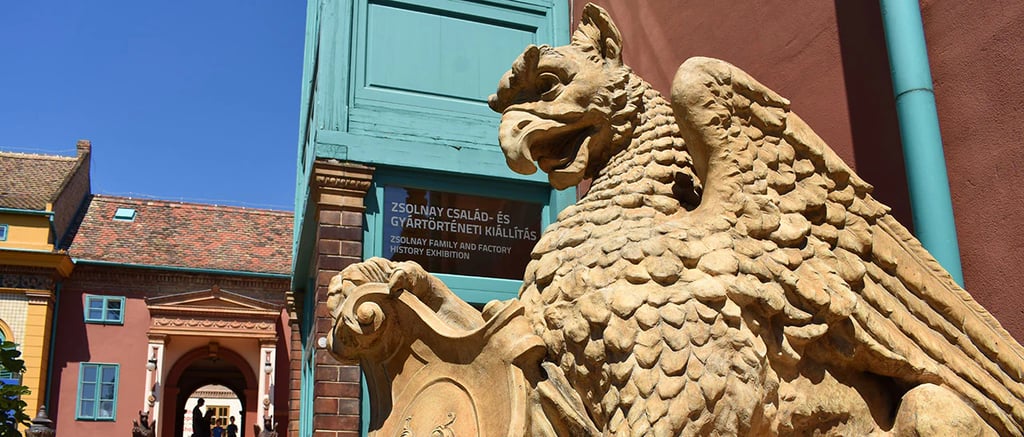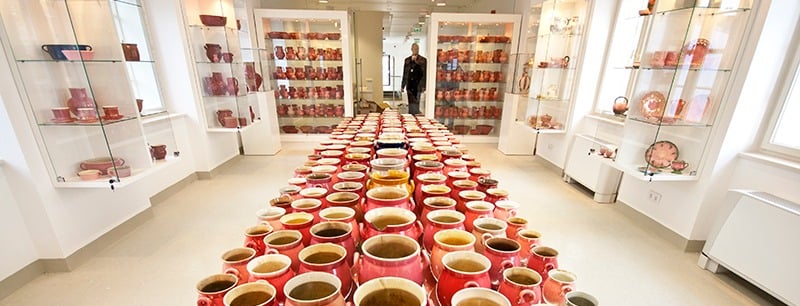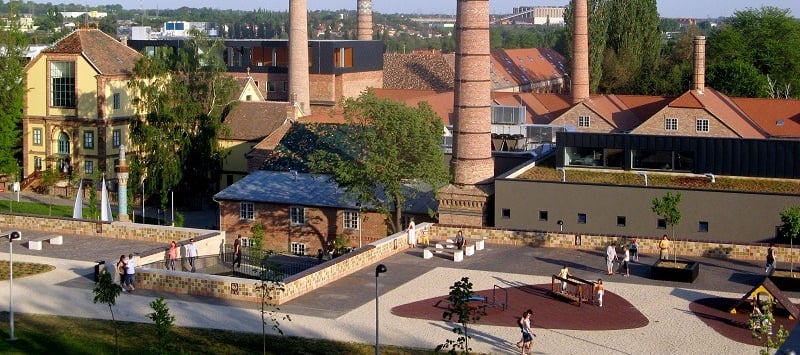Zsolnay Cultural Quarter: A Tapestry of Art, History, and Innovation
Unveil the vibrant legacy of Hungary's ceramic artistry in a realm where tradition meets contemporary culture.


The Heartbeat of Pécs in Porcelain
Pécs, one of Hungary’s most culturally radiant cities, holds many treasures, but none gleams quite like the Zsolnay Cultural Quarter. Sprawling across five hectares of what was once the beating heart of the Zsolnay porcelain empire, this sanctuary of creativity is more than a museum, more than a gallery, more than a park. It is a living, breathing, evolving fusion of art, science, craftsmanship, memory, and innovation. It is Hungary’s past glazed in eosin and fired for eternity.
To walk the paths of the Zsolnay Cultural Quarter is to follow the footsteps of visionaries and artisans. The quarter resurrects the spirit of a factory that didn’t just produce ceramics—it birthed a style, a symbol, a source of national pride that helped define Hungarian Art Nouveau. With every turn, visitors find themselves surrounded by shimmering tiles, sculptural rooftops, whimsical statues, and quiet pockets of creativity still echoing with the spark of a kiln’s fire.
The Origins: From Clay to Legacy
The roots of this magical place reach back to 1853 when Miklós Zsolnay founded a modest pottery workshop. But it was his son, Vilmos Zsolnay, who transformed it into a world-renowned artistic and industrial powerhouse. Under Vilmos's guidance, Zsolnay became synonymous with innovation. From the development of frost-resistant architectural ceramics to the creation of the mysterious eosin glaze, the factory flourished and left a permanent mark on Hungarian visual culture.
Eosin, in particular, became a symbol of Zsolnay mastery—a lustrous, iridescent glaze that could turn a simple vase into a galaxy of color. It was their secret alchemy, their answer to porcelain’s dull uniformity, and it stunned the world at World Fairs from Paris to Chicago. The Zsolnay brand was no longer just Hungarian; it was cosmopolitan, elegant, and unmistakable.
But then came wars, regime changes, and nationalization. The factory survived, but the soul of its legacy faded behind functional tiles and diminished artistry—until the city of Pécs reclaimed it.
In preparation for its designation as the European Capital of Culture in 2010, Pécs transformed the old factory grounds into the Zsolnay Cultural Quarter, restoring buildings, preserving art, and creating new spaces for education, celebration, and community. Today, what remains is not a museum of decline—but a phoenix risen from kiln ash.
The Gyugyi Collection: A Crown of Ceramics
At the core of the Quarter’s artistic offerings lies the Gyugyi Collection, the soul of the Zsolnay renaissance. László Gyugyi, a Hungarian-American collector, spent decades curating one of the largest private collections of historic Zsolnay pieces. His gift to Pécs—a gift of over 600 original Art Nouveau and historicist ceramics—is now enshrined in its own gallery within the Quarter.
Here, you walk among mythical beasts, stylized flowers, and golden-glazed forms so rich in detail they feel more like dreamscapes than dishware. Every piece in the collection is a meditation on beauty, from small ink pots to monumental vases adorned with iridescent dragons. The gallery whispers not of dusty nostalgia, but of creative daring, a visual symphony of shape, symbolism, and shimmer.
The Zsolnay Family and Factory Exhibition
Equally compelling is the Zsolnay Family and Factory Exhibition, which chronicles the life and ambitions of the remarkable Zsolnay clan. Original photographs, personal letters, factory tools, and business records paint an intimate portrait of a family devoted to beauty and excellence. You meet Vilmos not as a historical figure but as a passionate innovator. You feel the creative tension in his relationships with artists, architects, and chemists. You learn of the trials—financial, political, and personal—that shaped the factory’s destiny.
There is something emotional in this room, something vulnerable. It’s the heart of the Quarter—the human side of all that color and shine.
Pink Ceramics, Playful Science, and Living Traditions
One cannot speak of the Zsolnay Quarter without mentioning the Pink Zsolnay Exhibition, a vibrant and often overlooked corner of the factory’s history. These pastel pieces represent a brief but bold departure from the traditional eosin tones, showing the brand’s willingness to experiment—even when surrounded by legacy. Pink may not shimmer like gold, but in these delicately crafted ceramics, it radiates warmth and daring.
Nearby, the Zsolnay Live Manufacture offers a rare glimpse into living heritage. Here, trained artisans demonstrate the time-honored processes of shaping, glazing, and firing. You watch as raw clay transforms under practiced hands. You see the precision needed to apply fine detail, the chemistry required for color, the patience of the kiln. It is, quite literally, the art of time.
And then—amid all this porcelain poetry—you come upon the Labor – House of Playful Sciences, where scientific principles come to life through touch, sound, and light. This interactive exhibit is not a detour from art; it’s a continuation of it. Children bounce sound waves, build bridges, play with magnets. The Zsolnay spirit—restless, curious, endlessly creative—lives here too.
The Mausoleum: Where Light Rests
On a quiet hill just beside the Quarter lies the Zsolnay Mausoleum, perhaps the most poetic resting place in Hungary. Surrounded by pine trees and guarded by 42 lion statues, this Art Nouveau tomb was designed by Miklós Zsolnay himself. The entire building is adorned with eosin-glazed tiles that gleam green, blue, and gold under the shifting sunlight.
Legend whispers that Vilmos Zsolnay was buried here along with the exact formula of eosin glaze—locked away forever with the man who transformed clay into magic. Whether true or not, the mausoleum exudes mystique and reverence. It is not merely a grave. It is a shrine to vision.
A Place for All Seasons
The Zsolnay Cultural Quarter is not bound to one season or type of visitor. Spring brings blooming courtyards and open-air concerts. Summer fills the walkways with festivals, puppetry, and nighttime art projections. Autumn coats the red-brick walls with gold and rust, while winter transforms the Quarter into a glowing world of warm cafés, workshops, and quiet contemplation.
Whether you come as a family seeking wonder, an art lover chasing inspiration, or a traveler eager for a deeper story—Zsolnay welcomes you. Not with grandeur, but with craft. Not with noise, but with quiet brilliance.


The Creative Pulse: Culture in Motion
Far from being a static heritage site, the Zsolnay Cultural Quarter is alive with events, performances, and innovation year-round. It houses galleries, artisan shops, design studios, concert halls, and even a planetarium—all woven into the historical fabric of the old factory buildings. Whether you arrive during a quiet weekday or during one of the many festivals, you’re stepping into a dynamic cultural ecosystem.
Among the most celebrated events is the Zsolnay Light Festival, a spectacular visual arts and projection mapping event that transforms the entire Quarter—and much of downtown Pécs—into a city of light. Buildings become canvases, streets pulse with color, and digital artistry reanimates history in ways that seem to defy the laws of time and space.
Inside the Quarter, you’ll also find the Bóbita Puppet Theatre, one of Hungary’s oldest and most innovative puppet institutions. With performances for children and adults alike, this venue is a window into the whimsical, poetic storytelling tradition so vital to Central European culture.
Whether it's jazz in the courtyard, modern dance in the Zsolnay Hall, or a spontaneous ceramics workshop in a studio space, the message is the same: this is not a place where art is simply preserved—it is a place where art is made, played, lived, and reborn.
Food, Drink, and Soulful Rest
No creative space is complete without nourishment, and the Zsolnay Quarter does not disappoint. Cafés and bistros are tucked among the galleries and exhibitions, offering everything from traditional Hungarian pastries and soups to modern fusion fare and locally roasted coffee.
Sit beneath a Zsolnay-tiled eave with a steaming bowl of gulyás and listen to the distant sound of a flute echoing through the plaza. Or sip on Villányi red wine as dusk falls over the eosin-glazed rooftops, the fading sun turning each tile into a flickering flame. These small sensory moments—so easy to overlook—become cherished memories here.
For those wanting to linger longer, accommodations can be found within walking distance of the Quarter, or you can simply spend the whole day here, from museum visit to concert to candlelit dinner.


Visiting Information
📍 Location
Zsolnay Cultural Quarter
7626 Pécs, Zsolnay Vilmos u. 37, Hungary
Only a 15–20 minute walk from Pécs city center and easily reachable by local bus routes or taxi.
🕰 Opening Hours
Exhibitions: Tuesday–Sunday, 10:00 AM – 6:00 PM
Closed on Mondays
Restaurant and café hours vary slightly by season
🎟 Ticket Prices
There are both individual and combined tickets depending on what you’d like to explore. Prices in Hungarian forints (HUF) and approximate USD equivalents:
🎫 Zsolnay Quarter Pass (includes multiple permanent exhibitions):
Adults: 3,200 HUF (~$9)
Students/Seniors: 2,400 HUF (~$6.80)
Children (6–14): 1,600 HUF (~$4.50)
Family (2 adults + 2 kids): 8,000 HUF (~$23)
Under 6: Free
🎫 Individual Exhibitions (e.g. Planetarium, LAB, Puppet Theatre):
Range from 500 HUF – 1,500 HUF (~$1.40 – $4.20)
🎟 Tickets can be purchased on site or online in advance. Group discounts and educational tours are available.
♿ Facilities & Accessibility
Wheelchair-accessible paths and elevators
Multilingual signage and audio guides
On-site cafés, restrooms, baby changing stations
Free Wi-Fi in most zones
Guided tours in Hungarian, English, and German
Official Website and Social Media
Stay updated on events, opening hours, and exhibitions here:
🌐 Website: https://www.zsolnaynegyed.hu
📘 Facebook: https://www.facebook.com/zsolnaynegyed
📷 Instagram: https://www.instagram.com/zsolnaynegyed
📺 YouTube: https://www.youtube.com/@zsolnaynegyed








